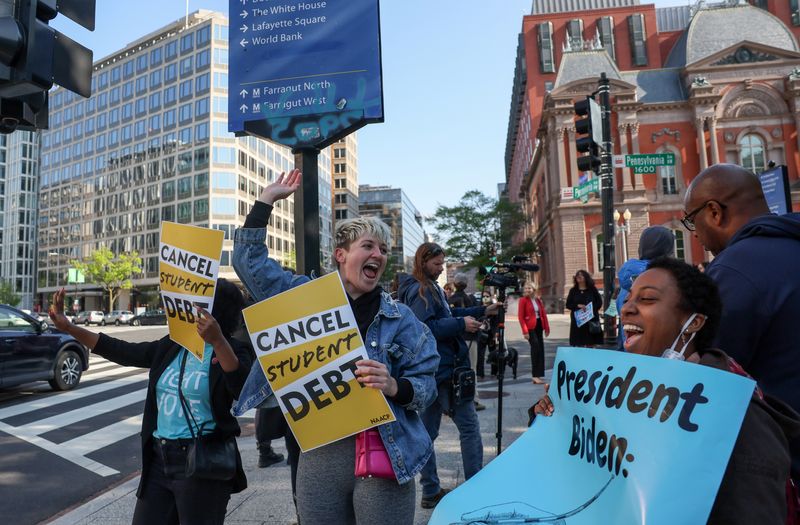By Chris Taylor
NEW YORK (Reuters) - As associate director of The Aspen Institute’s Financial Security Program, Katherine Lucas McKay considers tricky financial issues all day long.
But the Biden administration’s new U.S. student debt relief program is not just an academic subject for her. It is affecting her own pocketbook.
That is because McKay is still dealing with student debt from her days getting a graduate degree at Carnegie Mellon University. So she is not just studying the student debt relief application that went live the other day (https://studentaid.gov/debt-relief/application) – she is filling it out herself.
"On Saturday morning as I was sitting with my coffee, I decided to see if this was something I could do quickly on my phone," McKay says. "Speaking as someone who has filled out countless forms over the years: It was surprisingly easy. I was able to get through it in a few minutes."
That is good news for borrowers, who might be intimidated at the idea of navigating government bureaucracy. In fact, more than eight million people applied right off the bat, according to President Joe Biden. The White House estimates that more than 40 million Americans will be eligible for this debt relief, and almost 20 million could see their entire student loan balance wiped out.
But you are wise to go into the process armed with the right information, so it is as seamless and pain-free as possible. A few tips from the experts:
BE COGNIZANT OF TIMING
You have quite a long runway to apply for this program, with a deadline of Dec. 31, 2023. That being said, there is no reason to put it off.
"I would not recommend waiting," McKay says. "You want to get this initial application done as quickly as possible."
After all, the information requested is pretty straightforward: you need items like Social Security number, name, date of birth, phone and e-mail address.
When it comes to the Public Service Loan Forgiveness, however – a separate issue from the more general debt relief – the deadline is imminent. Temporary rules for expanded access to this program, which clears remaining debt for workers in public service-oriented jobs who have made 120 qualifying monthly payments, come with a deadline of October 31. (More information on this program:
KNOW WHAT’S COVERED AND WHAT’S NOT
Doing your due diligence on the program parameters will save any confusion or disappointment. The program applies to those with less than $125,000 in annual income in 2020 or 2021. The threshold is $250,000 for married couples filing jointly and for those filing as head of household. Recently enrolled students will likely be classified as dependents.
Amounts covered are up to $10,000, or $20,000 for recipients of Pell Grants, which is federal aid for lower-income students.
When and if the debt relief goes through, your loan servicer will let you know. Some borrowers whose financial information the government already has on file may get automatic relief, although you should apply anyway, just to cover all bases. Processing should take 4-6 weeks, but lawsuits from Republican-led states seeking to block the program could complicate matters.
Remember that depending on your personal situation, there could be some retroactive coverage here – for instance, for payments made during the pandemic period starting in March 2020, after which a moratorium was put in place.
KNOW THE TAX IMPLICATIONS
Under current tax laws, a handful of states – such as Indiana, Minnesota, North Carolina, Mississippi, California, Arkansas, and Wisconsin – could consider the amount of debt forgiveness as taxable, unless state legislatures take specific action. If you reside in one of those states, that’s information you will need to know come April 15.
BE PREPARED TO SUPPLY MORE INFORMATION
Filling out the application is an excellent step, but it may only be the first one. It is very possible you will be contacted again for subsequent information, so keep an eye out for any follow-up communications.
For instance, you might get picked to make sure the numbers provided are legit.
"A small sample of borrowers will be selected for verification, probably less than 10%," says student aid expert Mark Kantrowitz. "If you are selected, you will be asked to provide proof of income, such as an IRS tax return transcript." You can find it online using the IRS Get Transcript tool (https://www.irs.gov/individuals/get-transcript).
BEWARE OF SCAMS
The student debt relief program has already brought scammers out of the woodwork, warns the Federal Trade Commission (https://consumer.ftc.gov/consumer-alerts/2022/10/now-student-loan-debt-relief-application-open-spot-scams). Do not get bamboozled by people phoning you up and asking you to pay up-front application fees for debt forgiveness, or pressing you for credit-card information.

A corollary of that: Many private lenders are using this debt relief news to steer you into their own products, which may not be in your best interest.
"I've seen a flurry of advertising: 'After you get your loan forgiveness, refinance the rest with us!'" says McKay. "But that decision can have big consequences for people, both in terms of what you're giving up in consumer protections, and the ability to get loans forgiven in future."